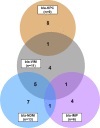Genotypic to Phenotypic Resistance Discrepancies Identified Involving β-Lactamase Genes, bla KPC, bla IMP, bla NDM-1, and bla VIM in Uropathogenic Klebsiella pneumoniae
- PMID: 32903880
- PMCID: PMC7445497
- DOI: 10.2147/IDR.S262493
Genotypic to Phenotypic Resistance Discrepancies Identified Involving β-Lactamase Genes, bla KPC, bla IMP, bla NDM-1, and bla VIM in Uropathogenic Klebsiella pneumoniae
Abstract
Introduction: Klebsiella pneumoniae carbapenemase (KPC) belongs to the Group-A β-lactamases that incorporate serine at their active site and hydrolyze various penicillins, cephalosporins, and carbapenems. Metallo-beta-lactamases (MBLs) are group-B enzymes that contain one or two essential zinc ions in the active sites and hydrolyze almost all clinically available β-lactam antibiotics. Klebsiella pneumoniae remains the pathogen with the most antimicrobial resistance to KPC and MBLs.
Methods: This research investigated the blaKPC, and MBL genes, namely, blaIMP, blaVIM, and blaNDM-1 and their phenotypic resistance to K. pneumoniae isolated from urinary tract infections (UTI) in Bangladesh. Isolated UTI K. pneumoniae were identified by API-20E and 16s rDNA gene analysis. Their phenotypic antimicrobial resistance was examined by the Kirby-Bauer disc diffusion method, followed by minimal inhibitory concentration (MIC) determination. blaKPC, blaIMP, blaNDM-1, and blaVIM genes were evaluated by polymerase chain reactions (PCR) and confirmed by sequencing.
Results: Fifty-eight K. pneumoniae were identified from 142 acute UTI cases. Their phenotypic resistance to amoxycillin-clavulanic acid, cephalexin, cefuroxime, ceftriaxone, and imipenem were 98.3%, 100%, 96.5%, 91.4%, 75.1%, respectively. Over half (31/58) of the isolates contained either blaKPC or one of the MBL genes. Individual prevalence of blaKPC, blaIMP, blaNDM-1, and blaVIM were 15.5% (9), 10.3% (6), 22.4% (13), and 19% (11), respectively. Of these, eight isolates (25.8%, 8/31) were found to have two genes in four different combinations. The co-existence of the ESBL genes generated more resistance than each one individually. Some isolates appeared phenotypically susceptible to imipenem in the presence of blaKPC, blaIMP, blaVIM, and blaNDM-1 genes, singly or in combination.
Conclusion: The discrepancy of genotype and phenotype resistance has significant consequences for clinical bacteriology, precision in diagnosis, the prudent selection of antimicrobials, and rational prescribing. Heterogeneous phenotypes of antimicrobial susceptibility testing should be taken seriously to avoid inappropriate diagnostic and therapeutic decisions.
Keywords: Bangladesh; Klebsiella pneumoniae; blaIMP; blaKPC; blaNDM-1; blaVIM; co-resistance; heteroresistance; urinary tract infections.
© 2020 Urmi et al.
Conflict of interest statement
The authors report no conflicts of interest in this work.
Figures



Similar articles
-
[Carbapenem resistance in ESBL positive Enterobacteriaceae isolates causing invasive infections].Mikrobiyol Bul. 2014 Jan;48(1):59-69. Mikrobiyol Bul. 2014. PMID: 24506716 Turkish.
-
Resistance and Co-Resistance of Metallo-Beta-Lactamase Genes in Diarrheal and Urinary-Tract Pathogens in Bangladesh.Microorganisms. 2024 Aug 5;12(8):1589. doi: 10.3390/microorganisms12081589. Microorganisms. 2024. PMID: 39203431 Free PMC article.
-
[Comparison of phenotypic methods and polymerase chain reaction for the detection of carbapenemase production in clinical Klebsiella pneumoniae isolates].Mikrobiyol Bul. 2017 Jul;51(3):269-276. doi: 10.5578/mb.57333. Mikrobiyol Bul. 2017. PMID: 28929963 Turkish.
-
A multicenter study of β-lactamase-producing Klebsiella pneumoniae isolated from university teaching hospitals of Urmia, Iran.J Infect Dev Ctries. 2019 Aug 31;13(8):690-697. doi: 10.3855/jidc.9985. J Infect Dev Ctries. 2019. PMID: 32069252
-
Detection of NDM-1 producing Klebsiella pneumoniae ST15 and ST147 in Iran during 2019-2020.Acta Microbiol Immunol Hung. 2021 May 8. doi: 10.1556/030.2021.01381. Online ahead of print. Acta Microbiol Immunol Hung. 2021. PMID: 33974553
Cited by
-
Subclinical Mastitis in Selected Bovine Dairy Herds in North Upper Egypt: Assessment of Prevalence, Causative Bacterial Pathogens, Antimicrobial Resistance and Virulence-Associated Genes.Microorganisms. 2021 May 29;9(6):1175. doi: 10.3390/microorganisms9061175. Microorganisms. 2021. PMID: 34072543 Free PMC article.
-
Surveillance of antimicrobial resistance in low- and middle-income countries: a scattered picture.Antimicrob Resist Infect Control. 2021 Mar 31;10(1):63. doi: 10.1186/s13756-021-00931-w. Antimicrob Resist Infect Control. 2021. PMID: 33789754 Free PMC article. Review.
-
Predominance of Acinetobacter spp., Harboring the blaIMP Gene, Contaminating the Hospital Environment in a Tertiary Hospital in Mwanza, Tanzania: A Cross-Sectional Laboratory-Based Study.Pathogens. 2022 Jan 4;11(1):63. doi: 10.3390/pathogens11010063. Pathogens. 2022. PMID: 35056011 Free PMC article.
-
Phenotypic and Genotypic Analysis of Bacterial Pathogens Recovered from Patients Diagnosed with Fever of Unknown Origin in Egypt.Antibiotics (Basel). 2023 Aug 7;12(8):1294. doi: 10.3390/antibiotics12081294. Antibiotics (Basel). 2023. PMID: 37627714 Free PMC article.
-
Strategies to Improve Antimicrobial Utilization with a Special Focus on Developing Countries.Life (Basel). 2021 Jun 7;11(6):528. doi: 10.3390/life11060528. Life (Basel). 2021. PMID: 34200116 Free PMC article. Review.
References
-
- Ambler RP. The structure of beta-lactamases. Philos Trans R Soc Lond B Biol Sci. 1980;289(1036):321–331. - PubMed
LinkOut - more resources
Full Text Sources
Miscellaneous

